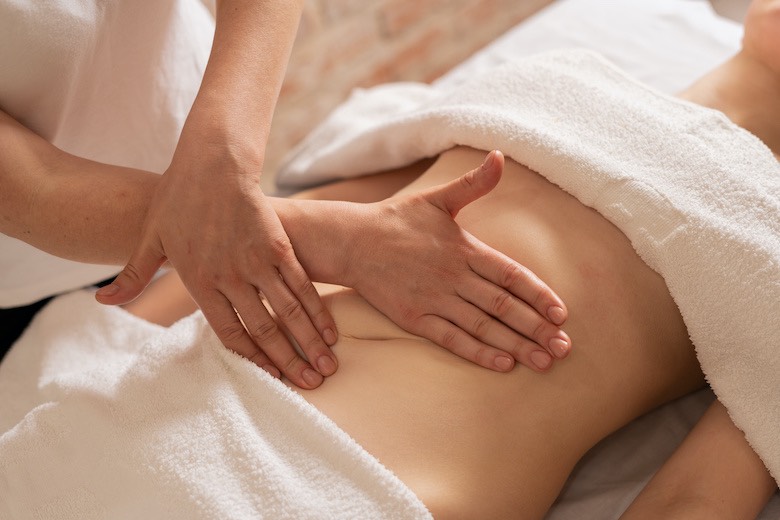


Lymphatic drainage, also known as manual lymphatic drainage, is a gentle, light-pressure massage treatment used to stimulate the circulation of lymph fluid throughout the body.
Before we go into any further detail, we first need to understand how the lymphatic system works.
The lymphatic system is our body’s version of a sewer system that removes waste, toxins and excess water from our cells. The excess leftover fluid from our tissues that does not get absorbed into the bloodstream is called lymph fluid. The lymph fluid is drained into lymph vessels and carried to lymph nodes which are largely located in our neck, armpits and groin. The lymph nodes contain white blood cells, called lymphocytes, that break down the bacteria, viruses or cancer cells the lymph carries. This filtering is a very important part of our immune system as it does not allow nasty substances to enter the bloodstream and thus protects us from infections and disease. The “clean” lymph fluid then enters the bloodstream which transports all waste products and destroyed bacteria to the liver or kidneys to be removed from our body.
Occasionally, the lymphatic system can become blocked and lymph fluid starts collecting in the arms and legs, making them swell. Since the lymphatic system does not have a pump (such as the heart) to push fluids around the body, it relies heavily on muscle movement and contractions – and this is where massage for lymphatic drainage becomes highly beneficial.
Lymphatic system massage is performed by a certified lymphatic massage therapist who uses various techniques to stimulate the lymphatic flow and move lymph from the tissues to the lymph nodes and thus reduce tissue swelling.
Lymphatic drainage therapy is often used to relieve painful swelling caused by lymphedema.
Lymphedema is the build-up of lymph fluid in the body’s soft tissues because of blockage or damage in the lymph nodes or vessels. The lymph fluid cannot drain so it causes painful swelling in the tissues – arms, legs, abdomen, genital area, head or neck. Lymphedema can occur following an injury, infection, surgery or cancer treatment.
When it is a result of surgery, lymphedema will only appear at the site of the procedure. If the lymph nodes under the right arm were removed, lymphedema would only affect the right arm, not the left one. Lymphatic drainage after surgery can significantly reduce the chances of developing lymphedema.
Lymphatic drainage massage benefits not only those with lymphedema but also those suffering from numerous other conditions, including:
Rheumatoid arthritis - as rheumatoid arthritis progresses it slows the lymphatic flow, causing tissue swelling, stiffness and pain in the joints. Manual lymph drainage can alleviate these symptoms.
Chronic venous insufficiency (CVI) - CVI prevents the veins in your legs from working properly and pushing the blood from the legs back to the heart. Although lymphatic therapy is not a permanent solution to CVI, it can help improve the performance of your veins and femoral artery - the large artery in the thigh.
Lipedema - lipedema is an enlargement of the legs caused by fat accumulation and can lead to lymphedema. Lymph nodes drainage massage can prevent the onset of lymphedema in this instance.
Fibromyalgia - fibromyalgia is a chronic condition that causes widespread musculoskeletal pain. Lymph nodes massage can help ease some of the symptoms of fibromyalgia.
In addition to alleviating some of the symptoms of the aforementioned conditions, a professional lymphatic drainage massage also:
Lymphatic drainage treatment can also help alleviate anxiety, reduce stress and even improve insomnia.

Lymph massage therapy is generally considered a safe treatment that promotes lymphatic flow and alleviates pain and swelling caused by lymphedema. However, it is not recommended for everyone.
You should avoid having lymph system drainage if you have:
It is always in your best interest to consult your doctor before scheduling a lymphatic massage. They can help explain the risks and the lymph drainage massage benefits you can experience.
Lymphatic body massage should be performed only by lymphatic drainage specialists. They will follow a particular sequence of lymphatic drainage techniques including stretching, compressing, gliding and cupping.
In general, the goal of lymph drainage therapy is to move the lymph toward your heart or the groin so your body can properly flush out the toxins. Your therapist will first massage the lymph nodes that drain a specific area to empty them. They will then massage the area that drains towards those lymph nodes that are now ready to take on more lymph fluid.
Manual lymphatic massage is gentle and rhythmic so you should not experience any pain or discomfort.
Lymph drainage treatments range from 30 to 90 minutes, depending on the condition. Your therapist will likely recommend at-home exercises, self-massage, skin brushing and compression bandaging that will continue to assist the lymph drainage process.

Although it is recommended to seek the help of a professional, you can perform a drainage massage at home by yourself.
Here are some tips on how to perform self-lymph drainage at home:
You could perform lymphatic system drainage three to four times a week by yourself. If you are visiting a professional, once or twice a week is usually enough.
If you are treating lymphedema or other medical conditions, it is best to leave a manual lymph drainage massage to the professionals. A certified lymphatic drainage specialist will have the knowledge and experience to stimulate your lymph flow more effectively.
Choose your city below and enjoy a full-body lymphatic massage done by experts.